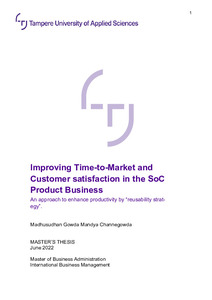Improving time-to-market and customer satisfaction in the SoC product business : an approach to enhance productivity by “reusability strategy”
Mandya Channegowda, Madhusudhan Gowda (2022)
Mandya Channegowda, Madhusudhan Gowda
2022
Julkaisun pysyvä osoite on
https://urn.fi/URN:NBN:fi:amk-2022061017281
https://urn.fi/URN:NBN:fi:amk-2022061017281
Tiivistelmä
The objective of this study was to gather information about possible pain points and identify the areas to improve time-to-market (TTM) for “Company X” in the embedded / SoC product development business. In addition to TTM, the research study was also to identify areas to further improve customer satisfaction during the after-sales support stage in the product life cycle.
The Thesis is based on the pragmatic philosophy and mixed methods approach, including qualitative and quantitative methods. The qualitative study carried out a semi-structured interview, and data were collected from 18 selected individuals across the organization. The data were analysed using qualitative content analysis.
The good inputs from qualitative interviews and empirical findings arrived at the questionnaire for the quantitative study with a survey. The purpose of the survey was to gather deeper insights into those empirical findings of qualitative research and get input from a broad audience. The quantitative survey data were collected from 116 individuals across the organization.
The combined results from both qualitative interviews and quantitative surveys were analysed together.
A detailed report is shared with “Company X” to take further steps on the findings and recommendations. There is a lot of scope for an additional research study focusing on specific areas and discussing the suggestions briefly.
This thesis includes the confidential information collected in Appendix B and excluded from the public report.
The Thesis is based on the pragmatic philosophy and mixed methods approach, including qualitative and quantitative methods. The qualitative study carried out a semi-structured interview, and data were collected from 18 selected individuals across the organization. The data were analysed using qualitative content analysis.
The good inputs from qualitative interviews and empirical findings arrived at the questionnaire for the quantitative study with a survey. The purpose of the survey was to gather deeper insights into those empirical findings of qualitative research and get input from a broad audience. The quantitative survey data were collected from 116 individuals across the organization.
The combined results from both qualitative interviews and quantitative surveys were analysed together.
A detailed report is shared with “Company X” to take further steps on the findings and recommendations. There is a lot of scope for an additional research study focusing on specific areas and discussing the suggestions briefly.
This thesis includes the confidential information collected in Appendix B and excluded from the public report.
